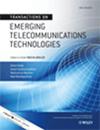L. F. Caro, D. Papadimitriou, J. Marzo
{"title":"以太网标签空间依赖于网络拓扑结构","authors":"L. F. Caro, D. Papadimitriou, J. Marzo","doi":"10.1002/ett.1412","DOIUrl":null,"url":null,"abstract":"Label space consumption has been studied in label-based forwarding architectures such as multi-protocol label switching (MPLS) to reduce forwarding table sizes and lookup complexity, to simplify network management, and to limit operational expenditures. On the other hand, nowadays label-based forwarding is also considered in the context of carrier class Ethernet architectures. Given that these architectures may use different label scopes (domain-wide vs. local) and size spaces (depending on their encoding), there is a need to analyse and compare the properties of their respective label spaces, particularly in terms of scalability. In this paper, the impact of topology characteristics on label space consumption is studied. The dependency on factors such as the number of nodes, the topology node degree and the network structure is determined (both analytically and via experimentation), allowing a detailed comparison between the properties of the evaluated label spaces. Proposed techniques that can be applied to improve label space usage for label-based Ethernet forwarding architectures are considered. The proposed methodology and results can serve as guidelines for the design of future label based forwarding architectures. Copyright © 2010 John Wiley & Sons, Ltd.","PeriodicalId":50473,"journal":{"name":"European Transactions on Telecommunications","volume":"86 1","pages":"491-503"},"PeriodicalIF":0.0000,"publicationDate":"2010-10-01","publicationTypes":"Journal Article","fieldsOfStudy":null,"isOpenAccess":false,"openAccessPdf":"","citationCount":"3","resultStr":"{\"title\":\"Ethernet label spaces dependency on network topology\",\"authors\":\"L. F. Caro, D. Papadimitriou, J. Marzo\",\"doi\":\"10.1002/ett.1412\",\"DOIUrl\":null,\"url\":null,\"abstract\":\"Label space consumption has been studied in label-based forwarding architectures such as multi-protocol label switching (MPLS) to reduce forwarding table sizes and lookup complexity, to simplify network management, and to limit operational expenditures. On the other hand, nowadays label-based forwarding is also considered in the context of carrier class Ethernet architectures. Given that these architectures may use different label scopes (domain-wide vs. local) and size spaces (depending on their encoding), there is a need to analyse and compare the properties of their respective label spaces, particularly in terms of scalability. In this paper, the impact of topology characteristics on label space consumption is studied. The dependency on factors such as the number of nodes, the topology node degree and the network structure is determined (both analytically and via experimentation), allowing a detailed comparison between the properties of the evaluated label spaces. Proposed techniques that can be applied to improve label space usage for label-based Ethernet forwarding architectures are considered. The proposed methodology and results can serve as guidelines for the design of future label based forwarding architectures. Copyright © 2010 John Wiley & Sons, Ltd.\",\"PeriodicalId\":50473,\"journal\":{\"name\":\"European Transactions on Telecommunications\",\"volume\":\"86 1\",\"pages\":\"491-503\"},\"PeriodicalIF\":0.0000,\"publicationDate\":\"2010-10-01\",\"publicationTypes\":\"Journal Article\",\"fieldsOfStudy\":null,\"isOpenAccess\":false,\"openAccessPdf\":\"\",\"citationCount\":\"3\",\"resultStr\":null,\"platform\":\"Semanticscholar\",\"paperid\":null,\"PeriodicalName\":\"European Transactions on Telecommunications\",\"FirstCategoryId\":\"1085\",\"ListUrlMain\":\"https://doi.org/10.1002/ett.1412\",\"RegionNum\":0,\"RegionCategory\":null,\"ArticlePicture\":[],\"TitleCN\":null,\"AbstractTextCN\":null,\"PMCID\":null,\"EPubDate\":\"\",\"PubModel\":\"\",\"JCR\":\"\",\"JCRName\":\"\",\"Score\":null,\"Total\":0}","platform":"Semanticscholar","paperid":null,"PeriodicalName":"European Transactions on Telecommunications","FirstCategoryId":"1085","ListUrlMain":"https://doi.org/10.1002/ett.1412","RegionNum":0,"RegionCategory":null,"ArticlePicture":[],"TitleCN":null,"AbstractTextCN":null,"PMCID":null,"EPubDate":"","PubModel":"","JCR":"","JCRName":"","Score":null,"Total":0}
引用次数: 3
Ethernet label spaces dependency on network topology
Label space consumption has been studied in label-based forwarding architectures such as multi-protocol label switching (MPLS) to reduce forwarding table sizes and lookup complexity, to simplify network management, and to limit operational expenditures. On the other hand, nowadays label-based forwarding is also considered in the context of carrier class Ethernet architectures. Given that these architectures may use different label scopes (domain-wide vs. local) and size spaces (depending on their encoding), there is a need to analyse and compare the properties of their respective label spaces, particularly in terms of scalability. In this paper, the impact of topology characteristics on label space consumption is studied. The dependency on factors such as the number of nodes, the topology node degree and the network structure is determined (both analytically and via experimentation), allowing a detailed comparison between the properties of the evaluated label spaces. Proposed techniques that can be applied to improve label space usage for label-based Ethernet forwarding architectures are considered. The proposed methodology and results can serve as guidelines for the design of future label based forwarding architectures. Copyright © 2010 John Wiley & Sons, Ltd.

 求助内容:
求助内容: 应助结果提醒方式:
应助结果提醒方式:


